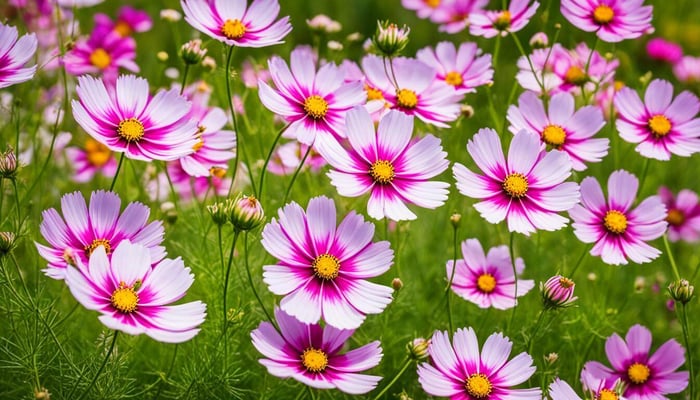Did you know that a single milkweed plant can be the nursery for hundreds of monarch butterfly caterpillars? As the primary habitat for these regal insects, learning to grow common milkweed from seed is more than a gardening activity—it's a conservation effort. My journey into milkweed germination began with a deep desire to contribute to nurturing monarch butterflies and to add beauty to my wildflower garden. Through this article, I'll unveil the steps to imbue your garden with life by growing this essential native plant from seed. Are you ready to learn how to grow common milkweed from seed and start helping to save the butterflies?
Key Takeaways
- Choosing the correct milkweed variety for your climate is crucial for successful growth and butterfly support.
- High-quality seeds are the foundation for robust milkweed germination and plant health.
- Milkweed plants serve as a wildflower and a vital part of the monarch's life cycle.
- Understanding the soil and care milkweed needs will enhance your wildflower garden's vitality.
- Anticipating the delight of observing butterflies flock to your garden is a rewarding experience.
Common Milkweed Seeds
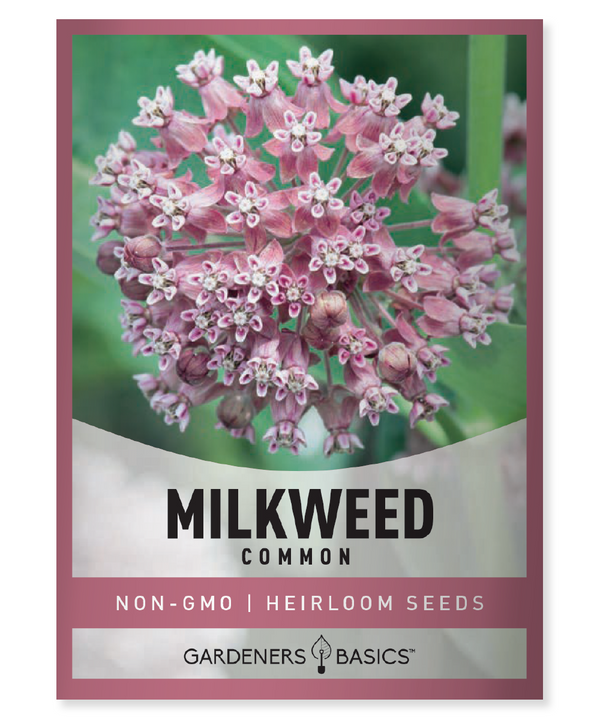
$2.49
Common Milkweed Seeds - Heirloom, Non-GMO, Non-Hybrid, Open-Pollinated Grow a butterfly and pollinator-friendly garden with our Common Milkweed Flower seeds! Perfect for attracting Monarch butterflies, bees, and other beneficial pollinators, these heirloom seeds are non-GMO, non-hybrid, and open-pollinated, ensuring pure,… read more
Common Milkweed Basics
- Days till maturity: Common Milkweed typically reaches maturity in its second or third year of growth, as the first year is usually spent establishing its root system.
- Planting depth: Seeds should be planted about 1/4 inch (6 mm) deep.
- Plant spacing: Space plants about 18 to 24 inches (45 to 60 cm) apart.
- Days to germination: Germination can take anywhere from 10 days to a few weeks, especially if the seeds haven't been stratified. Stratification (cold treatment) for 30 days can improve germination rates.
- Indoors or Direct Sown: Milkweed seeds can be sown directly outdoors in the fall or started indoors in early spring after stratification.
- Full Sun or Partial Shade: Common Milkweed prefers full sun but can tolerate partial shade.
- When to harvest: While typically not harvested for consumption, seed pods can be collected in late summer or fall when they begin to dry and split open.
- How tall does the plant get? Common Milkweed can grow about 2 to 5 feet (60 to 150 cm) tall.
- How wide does the plant spread? It can be about 2 to 3 feet (60 to 90 cm) wide.
- Native: Common Milkweed is native to North America.
- Family: Common Milkweed is a member of the Asclepiadaceae family, often included in the Apocynaceae family.
Understanding the Benefits of Milkweed for Butterflies and Biodiversity

When I first contemplated adding milkweed to my patch of native wildflowers, my motivation was simple: to help the struggling monarch butterflies. As much as it’s a beautiful plant, I realized that the milkweed benefits extend far beyond aesthetics, playing a vital role in supporting biodiversity within the ecosystem. Let's explore the multi-dimensional perks of this remarkable plant.
The heartwarming sight of monarchs gently hovering over a wildflower garden begins with these orange-and-black wonders laying their eggs exclusively on milkweed plants. Why milkweed? It’s the only host plant for monarch caterpillars, providing essential nourishment as they progress through their life stages. Milkweed leaves contain glycoside toxins that caterpillars ingest, making them less palatable to predators—a sly defensive trait passed down through the milkweed-monarch bond.
- Host for Larvae: Milkweed is indispensable for monarch larvae; it's where their life begins and flourishes.
- Nectar Source: Blooming milkweed offers nectar to various pollinators, enhancing the food web.
- Biodiversity: By planting milkweed, you're aiding monarchs and enriching local biodiversity.
While monarchs are the poster child for milkweed promotion, their benefit to the ecosystem is comprehensive. Below is a detailed overview of its ecological significance:
| Benefit | Description | Impact |
|---|---|---|
| Ecosystem Services | Stabilizes soil and reduces erosion with its deep roots | Improves soil health, water quality, and resistance to natural disturbances |
| Biodiversity Enhancement | A habitat provider and nectar source for bees, butterflies, and other pollinators | Supports food chains and plant-pollinator networks, crucial for sustainable ecosystems |
| Genetic Diversity | Wild milkweed species possess rich genetic variation and are resilient to environmental stresses. | Promotes adaptability and resilience against climate change and disease |
Milkweed stands as a beacon of life, from its roots to its iconic flowers. Far from just an element to beautify our gardens, its role in nurturing monarch butterflies and its inclusive invitation to biodiversity make it a top contender in our efforts to bolster ecosystem health. As gardeners and environmental stewards, growing milkweed lets us play a part in a much larger narrative of conservation and life.
How to Grow Common Milkweed From Seed
Embarking on the journey to grow milkweed from seed is an enriching endeavor for your garden and the biodiversity it supports. The success of nurturing milkweed into a full-fledged plant contributing to your wildflower garden soil begins with selecting milkweed seeds recognized for their quality and viability. Let's delve into the art of choosing and preparing these tiny heirs of ecological grandeur.
Selecting Quality Milkweed Seeds
For anyone passionate about attracting monarch butterflies, it's essential to begin with the right seeds. Heirloom seeds offer genetic diversity and robustness critical to a thriving milkweed population. Reputable sources such as Gardeners Basics are invaluable, providing pure seeds that can enhance germination rates.
Milkweed Seeds For Monarch Butterflies | 4 Variety Pack
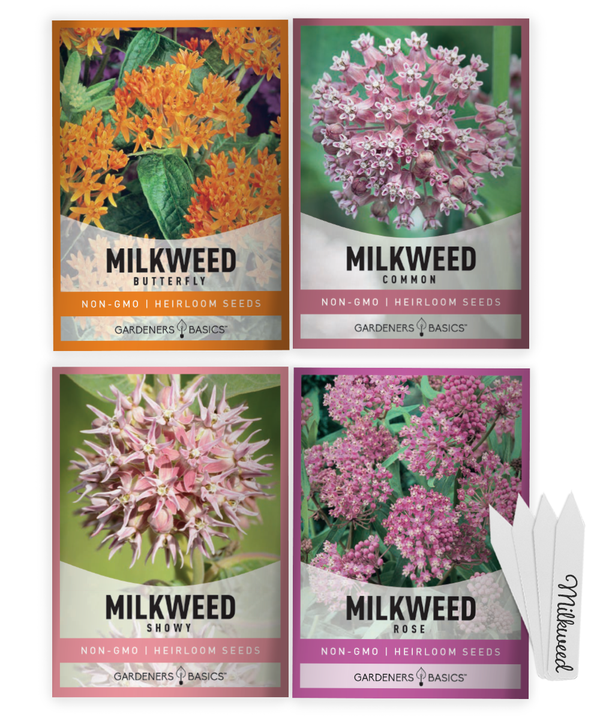
$9.95
Milkweed Seed Assortment For Planting – 4 Stunning Varieties to Attract Monarch Butterflies and Beautify Your Garden Transform your garden into a thriving paradise with our Milkweed Seed Assortment for Planting. This exclusive collection features four exquisite Milkweed varieties -… read more
Prepping Milkweed Seeds for Higher Germination Rates
With quality wildflower seeds in hand, the next step is preparing them for planting. Milkweed seed stratification is a technique that mimics natural winter conditions, breaking dormancy and triggering germination. This cold treatment process involves storing seeds in moist conditions and refrigerating them for a period, which is essential for increasing the success of your planting endeavors.
Creating the Ideal Soil Environment for Milkweed
Once the groundwork of understanding and prepping seeds is complete, the stage is set for planting milkweed seeds. Consider pH levels and necessary soil amendments to recreate the optimal soil environment for milkweed. A lush wildflower garden begins with a foundation of well-draining soil rich in organic matter—ideal for fostering milkweed growth.
To bridge the barrier between selecting and planting, I present a table that encapsulates the nuance of seed selection and the pragmatism of seed preparation. A combination of informed decisions and strategic actions will result in a bountiful wildflower habitat.
| Selection Criteria | Stratification Process |
|---|---|
| Source from reputable suppliers like Gardeners Basics | Cold-moist stratification for 30 days |
| Look for heirloom seeds to ensure genetic diversity | Use airtight containers with a moist medium |
| Ensure seeds have high viability and purity | Check seeds regularly to prevent mold growth |
In conclusion, enhancing germination rates begins with selecting milkweed seeds and ends with a meticulous stratification process. By understanding these steps, you create the foundation for a thriving oasis that invites the flutter of monarch wings into your garden.
Germination to Transplanting: A Step-by-Step Guide
As a gardener deeply invested in monitoring milkweed growth from the beginning, I can say there's a profound satisfaction in observing tiny seeds evolve into plants that reignite the lifecycle of monarch butterflies. Every aspiring gardener can embark on this heartwarming journey, but the real question is: Should you start sowing milkweed seeds indoors or outdoors? Understanding the advantages of each method sets the trajectory for successful milkweed growth.
Sowing Milkweed Seeds Indoors vs. Outdoors
Choosing between indoor germination and outdoor planting for milkweed seeds is the first step in your garden planning. Indoors, you have greater control over the environment, ensuring ideal moisture levels and temperature conditions for milkweed seedlings. It allows for an early start before the last frost, leading to robust plants. Conversely, sowing directly outdoors aligns with natural rhythms, requiring less labor and avoiding the need for transplanting.
Monitoring Moisture and Temperature for Optimal Growth
The essence of milkweed care lies in the perpetual monitoring of growth conditions. Whether indoors or out, maintaining optimal moisture and temperature is non-negotiable. A seedling heat mat and regular spritzing can simulate the perfect indoor germination climate, whereas the outdoor approach demands vigilance to protect against unpredictable weather that can impact milkweed growth.
Recognizing the Milkweed Seedlings' First Set of Leaves
Oftentimes, the real test of a gardener's acumen is identifying milkweed amidst impostors. When your milkweed seedlings debut with their first set of leaves or cotyledons, they might still resemble common garden weeds. The emergence of the second set, the first true leaves, reveals the iconic shape and texture distinctive to milkweed. This signals the transition from plant growth stages to earnest seedling care.
To encapsulate this roadmap from seed to seedling, I've compiled a guide encapsulating every aspect to ensure that your milkweed thrives from the onset of germination to the pride-filled moment of transplanting.
| Growth Stage | Indoor Approach | Outdoor Approach |
|---|---|---|
| Seed Preparation | Begin with stratification in the refrigerator for increased germination success. | Direct sowing in fall allows nature's winter cycle to stratify seeds. |
| Germination | Maintain temperature between 70-85°F. | Wait for nature to provide the ideal temperature range. |
| Monitoring Growth | Check daily for fungal growth and moisture levels. | Monitor environmental conditions that might affect germination. |
| First True Leaves | Identify the first true leaves and prepare them for transplanting once they are established. | Differentiate milkweed from weeds to ensure proper care. |
Ultimately, deciding whether to begin the milkweed growth journey indoors or outdoors rests on your preference, resources, and the surrounding climate. Whichever path you choose, patience and attention to detail, from ensuring the ideal moisture levels to carefully identifying milkweed, will lead to the satisfaction of nurturing monarchs' future habitat in your garden.
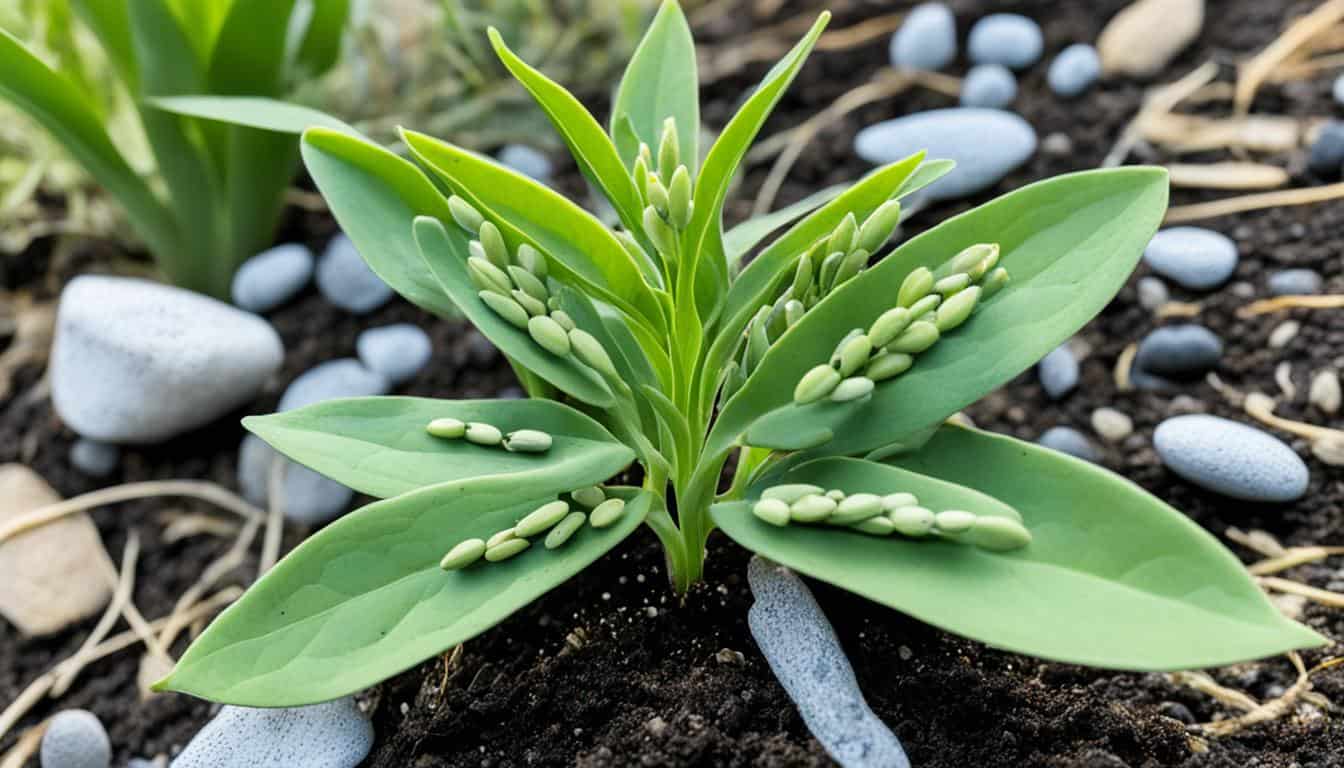
Maintaining Your Milkweed Plants for Season-Long Vitality
Beyond the initial thrill of germination and transplantation, maintaining milkweed in your garden for that season-long flower bloom comes down to consistent and mindful care. Whether it's ensuring robust garden vitality or the finer points of milkweed plant care, your strategies will influence your garden’s role as a monarch habitat. In this section, I will share my approaches to maintaining milkweed, ensuring you can enjoy its benefits throughout the growing season.
Firstly, watering practices can't be overlooked when maintaining milkweed. Like any plant, it's about finding that balance – overwatering and underwatering can be detrimental. So, I adhere to a simple rule: allow the soil to dry out slightly between waterings to encourage strong root development while being mindful not to let the plants wilt drastically. This promotes plant resilience and prepares it for spells of drought.
- Consistent monitoring of soil moisture levels;
- Utilizing mulch to conserve water and maintain root moisture;
- Adjusting watering frequency based on temperature and rainfall.
Fertilization is another aspect that cannot be ignored if one expects to bask in the joys of season-long flower bloom. Milkweed isn't particularly demanding, but an annual application of compost can invigorate growth. Synthetic fertilizers can sometimes do more harm than good, encouraging too much foliage at the expense of those magnificent blooms.
- Annually enriching the soil with organic compost;
- Avoiding high-nitrogen fertilizers that promote leaf growth over flowering;
- Emphasizing slow-release and natural fertilizers if necessary.
Wildflower, Perennial, & Annual Flower Seed Kit | 35 Variety Pack
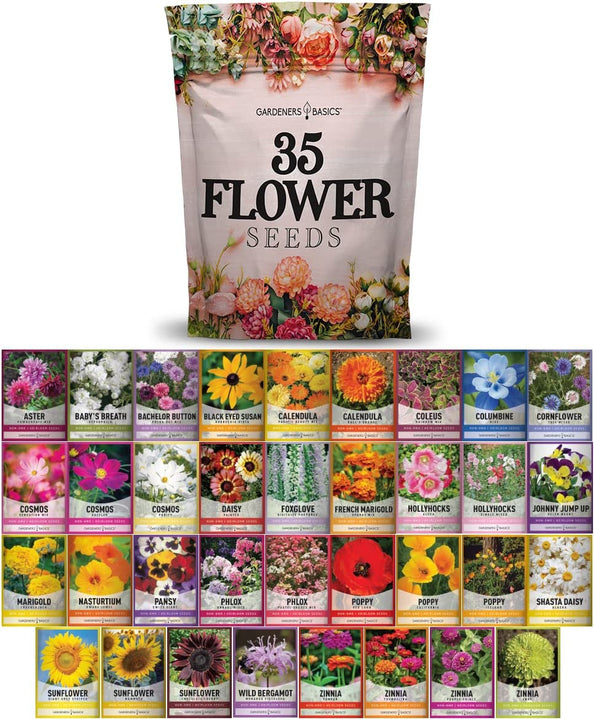
$29.95
$49.95
35 Flower Seeds Variety Pack – Heirloom, Non-Hybrid, Non-GMO, Open-Pollinated – Perfect for Pollinator-Friendly Gardens Transform your garden with our 35 Flower Seeds Variety Pack, offering a stunning and diverse selection of heirloom, non-hybrid, and non-GMO seeds. Each variety in… read more
Pests and diseases are inevitable adversaries in the garden. While milkweed is relatively hardy, aphids and milkweed bugs can sometimes establish a presence. Instead of reaching for chemical pesticides that could harm the butterflies we aim to attract, I opt for a gentler intervention. A strong jet of water can dislodge most pests, and manual removal can control their spread without upsetting the ecological balance.
- Regular inspections for pest activity;
- Biological control through inviting beneficial insects;
- Gentle intervention strategies for pest management.
Of course, the plant's life cycle requires attention. As the season winds down, allowing some plants to go to seed provides the next generation with the means to perpetuate the habitat. Meanwhile, other plants can be reduced to encourage new growth in the following season. Strategic pruning can even promote multiple flowering periods in a single growing season.
- Allowing several pods to mature for seed harvesting;
- Pruning to encourage new growth and further flowering;
- Allowing the plants to die back naturally at the season’s end to provide winter interest and habitat.
Maintaining a garden that upholds its vitality, showcases a superb flower bloom, and provides sustenance for monarchs requires dedication. Yet, even the most ordinary acts of care can feel imbued with purpose when you know they contribute to the ecosystem's health. Keep these tips handy for reference throughout the growing season to enjoy the flourishing presence of milkweed in your garden landscape.
Conclusion - How to Grow Common Milkweed From Seed
Reflecting on my growing milkweed journey, I am struck by the profound connection between the gardener's touch and the environmental tapestry we influence. Creating butterfly habitats has transformed my perception of gardening; it's no longer just a hobby but a significant contribution to healing our planet. Each seed nurtured, each flower bloomed, is a testament to the dedication we, as gardeners, commit to nurturing and enhancing garden biodiversity.
Reflecting on the Journey of Growing Milkweed
My gardener experiences have been rich with learning and growth, mirroring the metamorphosis of the monarchs I sought to invite. With its trials and triumphs, this endeavor reiterates the beauty of patience and persistence. There is a deep sense of fulfillment in knowing that each milkweed plant I've cultivated from seed stands as a beacon, not just for inviting monarch butterflies, but as a living, breathing component of a larger ecological community.
Inviting Monarchs: The Reward of Your Milkweed Endeavor
The milkweed rewards are most visible when flutters of vibrant wings dance among the blossoms—a clear sign of success in creating butterfly habitats. The arrival of monarchs to my garden validates the effort and care invested. They adorn the landscape, tying together the threads of beauty and purpose in what has blossomed into a thriving butterfly garden. This alliance of flora and fauna highlights the joy and responsibility we share in fostering these delicate yet vital relationships.
Exploring the Variety of Wildflower Seeds with Gardeners Basics
On this horticultural voyage, the alliance with Gardeners Basics in diversifying my collection of wildflower seeds variety was invaluable. Their diverse and robust seeds expanded the sanctuary I could offer to many pollinators, not just to monarchs. We must continue to support such endeavors, enhancing garden biodiversity and, in doing so, reinforcing our commitment to a balanced and resilient natural world. To those considering embarking upon their own journey—embrace the manifold wonders of milkweed and beyond for the beauty and health of our gardens and the cherished wildlife they support.
FAQ - Growing Common Milkweed for Monarch Butterflies
What are the first steps in growing Common Milkweed from seed?
The first steps include selecting high-quality, climate-appropriate milkweed seeds and preparing them for germination. It's important to source viable heirloom or quality wildflower seeds from reputable suppliers such as Gardeners Basics.
Why is Common Milkweed important for monarch butterflies and biodiversity?
Milkweed is a keystone species for monarch butterflies, providing essential nutrition and habitat for their caterpillars. It also supports many pollinators, promotes biodiversity, and improves overall ecosystem health.
How do you prep milkweed seeds to increase germination rates?
Prepping milkweed seeds typically involves a stratification process, which means giving them a cold treatment to mimic winter conditions. This enhances their chances of successful germination when planted.
What is the ideal soil environment for planting milkweed seeds?
Common Milkweed prefers well-draining, loamy soil with a moderate pH level. Amending garden soil with organic matter can help recreate these conditions, providing an ideal setting for milkweed growth.
Should I sow milkweed seeds indoors or outdoors?
The choice between sowing milkweed seeds indoors versus outdoors depends on your local climate and conditions. Indoor sowing allows for more control over the germination environment, while outdoor sowing may be easier but is subject to weather fluctuations.
How can I monitor and maintain ideal moisture and temperature for milkweed growth?
To maintain the right conditions, check the soil's moisture regularly and ensure that it remains consistently damp but not waterlogged. For optimal growth, keep the seedlings in a spot that maintains a steady temperature range, preferably between 70-85°F (21-29°C).
How can I identify that my milkweed seeds have successfully germinated?
You can identify germinated milkweed seedlings by looking for the first true set of leaves, which will have the distinct shape characteristic of milkweed. Be aware of look-alike seedlings and compare them with images or descriptions from reliable sources.
What long-term care do milkweed plants need?
Milkweed plants need regular watering (though they are drought-tolerant once established), occasional fertilization, and monitoring for pests or diseases. Deadheading spent blooms can also encourage further flowering.
What should I expect from my milkweed garden when it comes to attracting monarch butterflies?
After establishing your milkweed patch, you can expect to see monarch butterflies using the plants as both a food source and a breeding ground. The presence of these butterflies is a rewarding sign that your garden supports wildlife.
How can diversifying my wildflower garden benefit the ecosystem?
Incorporating a variety of native wildflowers from sources like Gardeners Basics can provide vital habitat and resources for a diverse range of pollinators and other wildlife, enhancing your garden's ecological value and health.
Gardening Seeds Kit - 105 Varieties of Vegetable, Fruit, Herb, and Flower Seeds
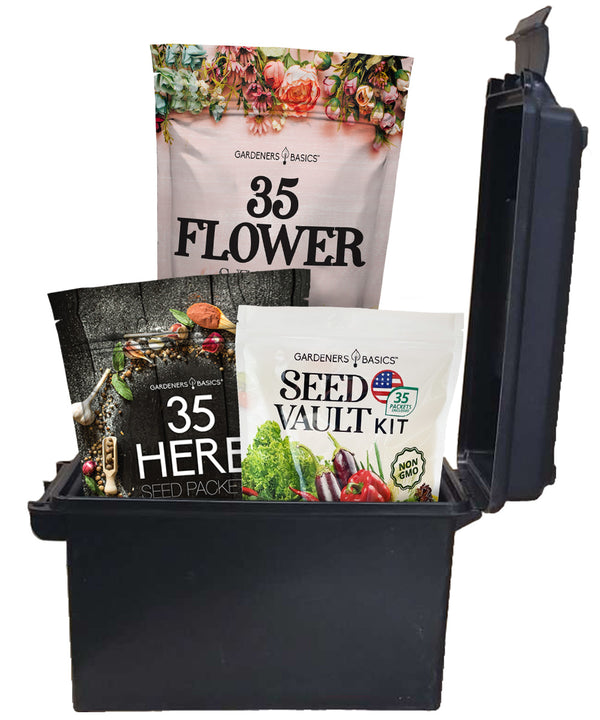
$82.95
$149.95
Ultimate Gardening Seeds For Planting Kit - 105 Varieties of Vegetable, Herb, and Wildflower Seeds - Non-GMO, Heirloom & USA Grown Introducing the ultimate Gardening Seeds Kit – your all-in-one solution for a bountiful and beautiful garden. This premium seed… read more







